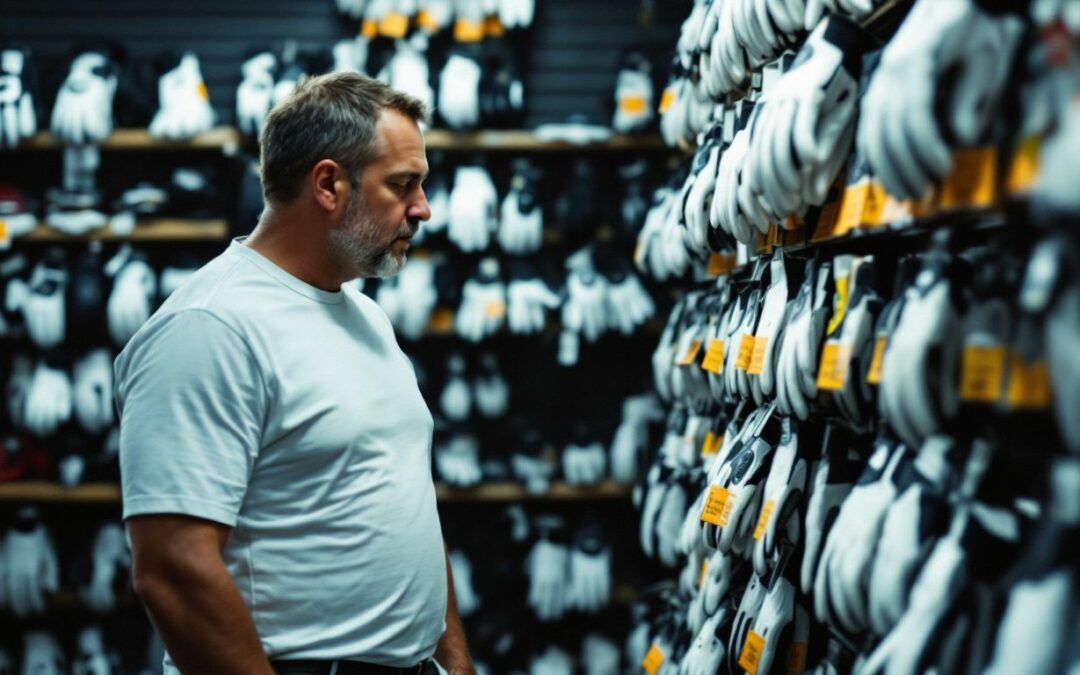Finding the right golf glove can feel tricky. Gloves improve grip, prevent blisters, and boost confidence during a golf swing. This guide will explain how to choose a glove that fits well and suits your needs.
Stick around—you won’t want to miss this!
Key Takeaways
- Golf gloves improve grip, prevent blisters, and enhance comfort during swings. Choose a glove based on fit, materials, and your game style.
- Right-handed golfers wear gloves on the left hand; left-handed golfers use them on the right. Some players even wear gloves on both hands for extra protection.
- Regular sizing is best for proportionate hands, while cadet sizing suits shorter fingers with wider palms for better control.
- Leather gloves like Cabretta offer softness and durability but need care to avoid drying out. Synthetic options provide flexibility and last longer in humid or rainy conditions.
- Maintain gloves by washing gently with cold water, air-drying flat, and storing properly. Rotate pairs if you play frequently to extend their life.
What Is the Purpose of a Golf Glove?

A golf glove improves grip and prevents slipping, especially during sweaty or humid conditions. It provides extra friction, helping players maintain control of their golf club for better swings.
It protects hands from blisters and callouses caused by repeated swings. Many PGA Tour pros, like Tiger Woods and Corey Pavin, rely on gloves to enhance feel without sacrificing comfort.
“A good glove can make the difference between confidence and struggle.
How to Choose the Right Golf Glove
Picking the right golf glove can boost your grip and comfort during play. Start with fit, focus on materials, and match it to your game style.
Understanding Hand Dominance
Right-handed golfers wear their golf glove on the left hand. This helps grip the club securely while swinging. Left-handed golfers, instead, put their glove on the right hand for the same reason.
Some players, like Tommy “Two Gloves” Gainey from the PGA Tour, take it a step further and wear gloves on both hands. While uncommon, this method can provide extra protection against blisters during long games or tournaments.
Gloves are a key part of golf accessories and can make handling irons and other clubs more comfortable. Always match your choice to your dominant playing style for better results!
Determining Your Glove Size
Measure the hand circumference around the first knuckle, skipping the thumb. Use a soft measuring tape for accuracy. Check the middle finger’s length too, as both measurements help in picking the perfect fit.
Gloves should fit snugly without bunching at the fingertips. If caught between sizes, start with the smaller one—it stretches over time like a well-worn shoe. Golf gloves that feel like second skin boost grip and prevent blisters during long games or tournaments.
Regular vs. Cadet Sizing
Regular sizing fits hands with standard palm and finger proportions. It works best for golfers with evenly balanced hand dimensions, providing a snug and natural fit. Tour players like Arnold Palmer often favored well-fitted gloves to grip golf clubs firmly without added tension.
Cadet sizing suits shorter fingers paired with wider palms. It eliminates loose fabric around the knuckles or fingertips. Golfers experiencing heel wear on their glove may need this option if gripping clubs too close to the end becomes an issue.
Proper size ensures comfort, better control, and blister prevention during golf tournaments.
Choosing materials next impacts durability and feel.
Materials Used in Golf Gloves
Golf gloves come in a variety of materials, each offering different comfort and performance—read on to find what suits your swing best!
Leather
Leather gloves are the go-to choice for many tour players. Cabretta leather stands out due to its softness and durability. It offers a second-skin feel, making it perfect for gripping golf clubs during long games.
FootJoy Pure Touch Limited gloves retail at $30 and feature premium Cabretta leather designed for comfort.
Titleist Players gloves, priced at $25, combine smooth leather with minimal seams for better control. Callaway Tour Authentic adds Griptac technology to enhance grip without losing the soft texture of Cabretta leather.
Leather gloves mold to your hand over time but require care. They may dry out if left in your golf bag too long or exposed to extreme weather while playing rounds like Fred Couples on a sunny day!
Synthetic Materials
Synthetic golf gloves offer affordability and durability. These gloves, like Callaway Opti-Fit made with premium Japanese synthetic material for $15, are ideal for golfers seeking budget-friendly options.
Unlike cabretta leather gloves, synthetic ones resist wear and tear over time while maintaining flexibility.
Breathable gloves made from synthetics keep hands comfortable during long games. PGA Tour players often favor hybrids that combine these materials for their balance of grip and endurance.
Synthetic components also perform well in humid or rainy conditions, making them reliable golf accessories year-round.
Hybrid Options
Hybrid golf gloves mix leather with synthetic materials for the best of both worlds. They offer durability, flexibility, and comfort without breaking the bank. For example, Nike Dura Feel VIII gloves cost $12 and feature a natural leather palm paired with stretch fabric.
This design provides grip where it matters while allowing movement.
Tour players often choose hybrid options because they balance performance and price. These breathable gloves reduce sweat while still feeling soft during swings. The combination is ideal for golfers who want versatility on any course or weather condition.
Next up: Tips for Maintaining Your Golf Glove!
Tips for Maintaining Your Golf Glove
Taking care of golf gloves can make them last longer. Proper maintenance also keeps them comfortable and effective.
- Wash with cold water and a mild dish detergent. This helps remove dirt and sweat without damaging the glove material.
- Scrub gently while still wearing the glove. Doing this gives support and prevents stretching the shape.
- Rinse thoroughly under running water. Any leftover soap can stiffen the material, so make sure it’s clear.
- Air dry for several hours on a flat surface. Avoid using dryers or direct sunlight, as they can shrink or crack leather gloves like those made of cabretta leather.
- Wear the glove briefly after rinsing to reshape it during drying. This ensures the fit doesn’t change over time.
- Store in a cool, dry spot inside your golf bags or accessories pouch to prevent moisture buildup. A microfiber cloth can help wipe it down after use.
- Rotate between two pairs if you play often, like PGA Tour players do with their breathable gloves. This reduces wear on a single pair from constant use.
Conclusion
Choosing the right golf glove can make a big difference in your game. The proper fit offers better grip, comfort, and protection. Whether you prefer leather or synthetic materials, focus on size and style.
Don’t forget to care for your gloves to keep them lasting longer. A well-chosen glove is more than an accessory—it’s a tool for success on the course!
FAQs
1. How do I know the right golf glove size for me?
Measure your hand circumference around the knuckles, excluding the thumb. If you have shorter fingers and wider palms, look into cadet sizing.
2. What material should I choose for a golf glove?
Cabretta leather is soft and provides excellent grip, often favored by tour players. Breathable gloves are great for hot weather to keep hands dry.
3. Do left-handed golfers need different gloves than right-handed ones?
Yes, left-handed golfers wear their glove on the right hand, while right-handed golfers wear it on the left hand.
4. Can wearing a golf glove prevent blisters?
Absolutely! Golf mitts reduce friction during swings and help protect against blisters over long games or practice sessions.
5. Why do PGA Tour players prefer specific gloves?
Tour players often pick gloves made from premium materials like cabretta leather for better feel and control in every shot they take.

